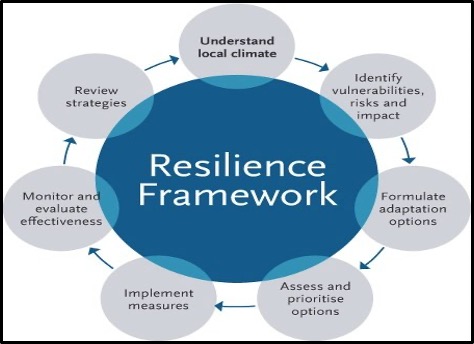Sponge-city concept and Guwahati’s growing urban challenge
Syllabus:
GS 3:
- Environment, Climate Change and its effects
- Climate Mitigation strategies
Focus:
The sponge-city concept was discussed in the IE Thinc: CITIES series, focusing on Guwahati’s growing urban challenges, including flooding and drought. Experts deliberated on ways to implement sustainable urban planning to mitigate these issues.
Issues in Urban Planning
- Governance Gap: Guwahati’s planning is disconnected from citizen needs, with the Guwahati Metropolitan Development Authority (GMDA) sidelining the municipal corporation.
- Broker Influence: Urban development is heavily broker-controlled, leading to haphazard construction and sub-letting of land, harming the city’s structural integrity.
- Drainage Plan: The 1972 drainage plan was never fully implemented due to resource limitations, leaving Guwahati with a patchwork drainage system.
- Encroachments: Open spaces were minimized in the master plan, with only 0.02% of land allocated, all of which has been encroached upon.
- Positive Changes: Recent adoption of town planning schemes and renewed focus on drainage improvements show promise for addressing some long-standing issues.
Building a Climate-Resilient City
- Integrated Resilience: Resilience must be central to urban planning in Guwahati, with considerations for local hazards like flooding and slope instability.
- Gaps in Policy: Despite policy submissions, projects are implemented in piecemeal, resulting in slow progress on making Guwahati climate-resilient.
- Simple Measures: Banning basements in flood-prone areas and analyzing slopes can prevent common issues like waterlogging and landslides.
- Green Solutions: Enhancing green spaces for water absorption can provide natural flood mitigation, improving the city’s response to heavy rainfall.
- Community Involvement: NGOs and local institutions should play active roles in governance, fostering local resilience and effective disaster response
Roadblocks in Implementation
- Drainage Challenges: Guwahati’s topography, with steep hills and low-lying areas, makes effective drainage difficult, requiring substantial infrastructural investments.
- Funding Limitations: Guwahati needs Rs 50,000 crore for infrastructure improvements, a financial challenge given the state’s limited budget.
- Wetland Restoration: Reclaiming natural wetlands and sponges could help restore Guwahati’s pre-1960s water management systems and address the flooding issue.
- Drainage Divide: The ridge near the district collector’s office marks the drainage divide, complicating the natural water flow across the city.
- British Warnings: The British advised against developing Guwahati, labelling it an unhealthy location due to its challenging terrain and poor drainage.
Roadmap for a Liveable City:
- Severe Paving: Excessive cementing in Guwahati has hindered water percolation, contributing to both floods and droughts, with no focus on groundwater recharge.
- Traditional Methods: Rural methods, like terraced water pools, offer valuable lessons for modern urban water management in Guwahati.
- Sponge-City Concept: The sponge-city model uses landscapes to absorb and release water, addressing urban flooding and drought by promoting natural water management.
- Macro Solutions: Reviving catchment areas and restoring channels like the Bhoroglu River are key to addressing Guwahati’s flooding issues.
- Green Infrastructure: At a neighbourhood level, integrating ponds and parks, with community involvement, could provide local flood and drought mitigation.
Accommodating Growth
- Historical Understanding: City planning must recognize Guwahati’s historical context, including its natural forms and past development, to chart a sustainable future.
- Platform for Engagement: A participatory platform is necessary for including all voices in city planning, ensuring civil society and citizen engagement.
- Role of GMC: The Guwahati Municipal Corporation should lead city planning efforts to bridge the gap between technocrats and the people.
- Smart City Concerns: Questions remain on how Smart City funds are utilized and who benefits, emphasizing the need for more transparency in urban development projects.
- Local Expertise: Guwahati’s residents possess valuable local knowledge, and involving them in the planning process can shape a more inclusive, sustainable city future.
Challenges
- Governance Disconnect: Guwahati’s urban planning excludes public participation, with the GMDA sidelining the municipal corporation, creating a governance gap.
- Inadequate Drainage: The failure to implement the 1972 drainage plan left the city with inadequate drainage systems, resulting in frequent waterlogging.
- Excessive Urbanization: Rapid and unplanned urban development, driven by brokers, has led to loss of open spaces and environmental degradation.
- Financial Constraints: The estimated cost of addressing infrastructural challenges like drainage and pumping stations is prohibitive for Assam’s limited budget.
- Erosion of Wetlands: The city’s natural water sponges, like wetlands, have been reclaimed for urban development, worsening flood and water management issues.
Building Climate-Resilient Cities in India: Key Initiatives● Jal Shakti Abhiyan ● National River Conservation Plan ● Decentralized Wastewater Treatment ● Green Building Technologies ● Nature-Based Solutions |
Way Forward
- Community Participation: A platform must be established to involve local citizens, civil society, and experts in urban planning processes.
- Reviving Wetlands: Restoring natural wetlands and catchment areas can help mitigate floods and improve water absorption in the city.
- Sponge-City Approach: Implementing sponge-city principles—using green spaces to absorb and release water—can address both flooding and drought.
- Infrastructure Investment: Prioritizing affordable infrastructure improvements, such as modern drainage systems, is essential to combat frequent flooding.
- Inclusive Planning: Urban planning should involve NGOs, community organizations, and marginalized groups to ensure sustainable, resilient development.
Conclusion:
Guwahati’s urban challenges, exacerbated by unplanned development and inadequate infrastructure, require integrated solutions. The sponge-city concept offers a sustainable pathway forward, blending environmental restoration with participatory governance to create a resilient urban ecosystem.
Source:
Indian Express
Mains Practice Question:
“Discuss the challenges in urban planning faced by rapidly growing cities like Guwahati. Suggest sustainable solutions like the sponge-city concept to address flooding and droughts.”
Associated Article:
https://universalinstitutions.com/tag/climatechangemitigation/




